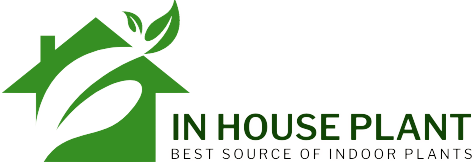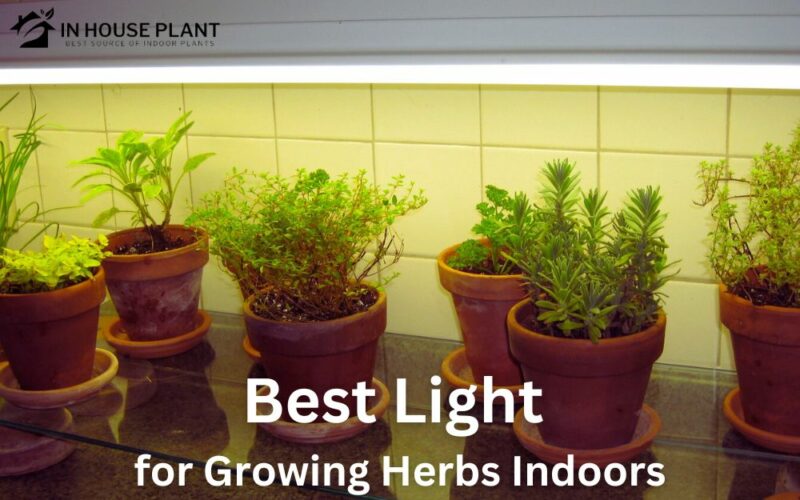My friend was interested in having an indoor herb garden for lovely cats but she didn’t have a place with proper sunlight in her house. I helped her use an under-cabinet grow light for herbs to make her wish come true. Here, I want to share with you my knowledge and experiences and tell you what is the best indoor grow lights for herbs.
I, as a horticultural consultant, think the best light for growing herbs indoors is a full-spectrum grow light. You must know your herbs require a minimum of 6-8 hours of sunlight per day to thrive healthy. So, you have to have access to sufficient natural light, if you don’t have it, otherwise using artificial grow lights is essential.
Join me in this post to provide you with a few options to consider with tips about using them. I hope after reading this post you can find the best grow light for growing your herbs indoors.
What Is the Best Light for Growing Herbs Indoors?
In the following, I listed the best indoor grow lights for herbs. Depending on your budget, the size of your garden, and the availability of your local market, you can choose one of them.
LED grow lights:
I put LED grow lights first on my list because found them the best light for growing herbs indoors. LED (Light Emitting Diode) lights are popular for indoor herb gardens.
Advantages:
- They are energy-efficient
- They produce less heat
- They provide a full spectrum of light suitable for plant growth.
Look for LED grow lights specifically designed for plants, preferably with adjustable brightness and colour temperature settings.

Fluorescent grow lights:
Two types of fluorescent grow lights are in the market:
- Compact fluorescent lights (CFL)
- Fluorescent tube lights
I found that both are also suitable for growing herbs.
Advantages:
They are affordable and widely available.
I recommend choosing “cool white” or “daylight” spectrum bulbs, as they provide a good balance of light for plant growth. In addition, I found out that to gain the best result you must keep the lights close to the plants, maintaining a distance of 4-6 inches (10-15 cm) to ensure sufficient light intensity.
High-Intensity Discharge (HID) lights:
If you have a large indoor herbs garden, I recommend using High-Intensity Discharge (HID) lights. You can find two types of HID lights in the market:
- Metal Halide (MH) lights
- High-Pressure Sodium (HPS) light
I found out both of them can be powerful options commonly used in larger indoor herb gardens. In addition, I think they are more suitable if you plan to grow other plants alongside herbs.
However, please note that HID lights can be quite intense and generate more heat, so proper ventilation and cooling measures are necessary.
Recommendations for using indoor grow lights for herbs
- When using grow lights, ensure they are placed at the appropriate distance from the herbs to avoid excessive heat or light burn. Follow the manufacturer’s recommendations for the specific light you choose, as different lights have different optimal distances.
- It’s also worth noting that herbs benefit from a period of darkness for healthy growth. Provide them with 12-16 hours of light per day, and allow 8-12 hours of darkness for rest. Use a timer to automate the light cycle.
- Remember to monitor your herbs closely and adjust the lighting accordingly. If the plants are stretching or becoming leggy, it may indicate insufficient light, and you may need to increase the light intensity or duration.
- By providing the right type and duration of light, you can create an optimal growing environment for your indoor herb garden and ensure healthy growth and abundant harvests.
The recommended distance between LED grow lights and herbs

- ➡ Depends on the wattage and intensity of the lights, as well as the specific needs of your herbs. As a general guideline, it is recommended to keep LED grow lights about 12-24 inches (30-60 cm) away from the tops of the herbs.
- ➡ However, it’s important to note that different LED lights have varying intensity levels and coverage areas. Some lights may be more powerful and require a greater distance, while others may be less intense and can be placed closer to the plants. Therefore, it’s always best to refer to the manufacturer’s instructions or guidelines provided with your LED grow lights.
- ➡ Additionally, it’s a good practice to observe the plants closely after setting up the lights. Monitor how the plants respond to the light intensity and adjust the distance accordingly. If the herbs appear to be stretching or the leaves show signs of light burn (brown or yellow spots), it may indicate that the lights are too close and need to be raised. On the other hand, if the plants are not receiving enough light, they may appear leggy or have weak growth, indicating that the lights need to be moved closer.
- ➡ Remember that each herb may have different light requirements, so it’s important to consider their specific needs when determining the distance between the LED grow lights and the plants. Regularly monitor the plants’ growth and make adjustments as needed to maintain optimal lighting conditions for healthy and vigorous herb growth.
Signs that your Herbs may not be Receiving Enough Light
- Leggy growth: If the stems of your herbs are long and spindly, with widely spaced leaves, it usually indicates insufficient light. Plants stretch and grow taller as they try to reach for more light. This is a common response to low light conditions.
- Small and pale leaves: When herbs don’t receive enough light, their leaves may be smaller than usual, and they may appear pale or yellowish. Inadequate light hampers the plant’s ability to produce chlorophyll, resulting in weak and pale foliage.
- Slow growth: Insufficient light can slow down the growth rate of herbs. If you notice that your herbs are not growing as quickly as expected or are significantly smaller than they should be, it could be a sign of inadequate light.
- Leaf drop: Some herbs may drop their leaves when they don’t receive enough light. If you notice leaves falling off your herbs, especially from the lower parts of the plant, it could be a response to low light levels.
- Lack of flowering or fruiting: Herbs typically require sufficient light to produce flowers and eventually form seeds or fruits. If your herbs are not flowering or producing fruits, it could be due to insufficient light.
It’s important to note that different herbs have varying light requirements, so the signs of inadequate light may vary slightly between species. If you observe any of these signs, it’s a good idea to assess the lighting conditions and make adjustments. Consider providing more light by adjusting the distance between the plants and the light source, increasing the light intensity, or extending the duration of light exposure.
Regularly monitoring your herbs and ensuring they receive adequate light will help maintain their overall health, promote robust growth, and enhance their flavour and aroma.
Some Examples of Herbs with Varying Light Requirements
Basil: Basil generally prefers bright, direct sunlight for at least 6-8 hours a day. It thrives in full sun conditions and can become leggy if grown in low light. Providing ample light will help promote strong growth and flavorful leaves.
Parsley: Parsley is a versatile herb that can tolerate partial shade but prefers bright, indirect light. It can grow well with 4-6 hours of sunlight per day. Insufficient light can result in slower growth and thinner leaves.
Mint: Mint can tolerate a range of light conditions, from partial shade to full sun. However, it tends to do best in bright, indirect light or dappled sunlight. Too much direct sun can scorch the leaves, while low light may result in leggy growth.
Rosemary: Rosemary is a sun-loving herb that thrives in full sun exposure for 6-8 hours a day. It appreciates intense light and warmth. Insufficient light can cause the plant to become weak and spindly.
Chives: Chives are relatively adaptable and can tolerate a range of light conditions. They grow well in bright, indirect light or partial shade. However, they may not thrive in low light conditions, and insufficient light can lead to weak growth.
Thyme: Thyme is a Mediterranean herb that enjoys bright light and appreciates full sun exposure for at least 6 hours a day. It can tolerate slightly lower light levels, but insufficient light may result in leggy growth and less flavorful leaves.
Cilantro/Coriander: Cilantro prefers bright, indirect light or partial shade. It can tolerate some direct sun in cooler climates but can bolt (go to seed) quickly in hot, intense sunlight. Providing the right balance of light is important to maintain a continuous supply of fresh leaves.
These plants are ideal and I recommend reading my other post to find various stunning ideas for your indoor herb garden.
Some Herbs that Can Tolerate Lower Light Conditions
Mint (Mentha spp.): While mint prefers bright, indirect light, certain varieties like spearmint (Mentha spicata) and peppermint (Mentha × piperita) can tolerate partial shade and lower light conditions. They can be a good option for areas with less natural light.
Lemon Balm (Melissa officinalis): Lemon balm is a herb that can thrive in partial shade or dappled sunlight. It can tolerate lower light conditions but still benefits from some direct sunlight. It has a pleasant lemony fragrance and is commonly used in teas and culinary recipes.
Oregano (Origanum vulgare): Oregano is a herb that is known for its hardiness and ability to tolerate a variety of conditions. While it prefers full sun, it can also grow reasonably well in partial shade or lower light conditions. It may have slightly slower growth in lower light but can still produce flavorful leaves.
Parsley (Petroselinum crispum): Parsley is a versatile herb that can tolerate partial shade and lower light conditions. While it prefers bright, indirect light, it can adapt to shadier spots. Flat-leaf parsley tends to be more tolerant of lower light compared to curly-leaf parsley.
Cilantro (Coriandrum sativum): Cilantro is an herb that can tolerate some shade or lower light conditions, especially in warmer climates. However, it’s important to note that cilantro is prone to bolting (going to seed) quickly in higher temperatures, so providing some direct sunlight or supplemental grow lights can help maintain its leafy growth.
Chervil (Anthriscus cerefolium): Chervil is a herb that prefers partial shade or filtered light. It is known for its delicate leaves and subtle anise-like flavour. It can be a good option for indoor herb gardens or areas with less direct sunlight.
Some Specific Types of Grow Lights that Would be Suitable for Herbs that Can Tolerate Lower Light Conditions
LED Grow Lights:
As told you above the LED grow lights are versatile and energy-efficient options suitable for growing herbs in low light conditions. I recommend looking for LED lights that provide a full spectrum of light with a balanced intensity.
People often ask me what color grow-light for herbs, I recommend providing a color temperature between 5000K to 6500K, it is generally suitable.
Adjustable LED grow lights are better due to allow you to customize the brightness and color settings according to your plants’ needs.
T5 Fluorescent Lights:
I think the T5 fluorescent lights are another good option for herbs in low-light environments. I like them because they provide a higher light output and are available in various lengths and configurations.
I often choose T5 grow lights with a color temperature between 5000K to 6500K for optimal herb growth.
Please adjust the height of the lights as needed to maintain the recommended distance of 4-6 inches (10-15 cm) from the plants.
Compact Fluorescent Lights (CFL):
If you are looking for an affordable and energy-efficient option for growing herbs in lower light conditions, I recommend CFL grow lights.
I recommend CFL bulbs with a color temperature between 5000K to 6500K, which provides a cool white or daylight spectrum similar to natural sunlight.
To gain maximum light intensity, I think you should close bulbs to the plants 4-6 inches (10-15 cm) away.
High-Output Fluorescent (HO) Lights:
I also recommend High-output fluorescent lights for growing herbs in low light, you can find various types such as T8 or T12 bulbs in the market. I think they are good because they offer higher lumen output compared to standard fluorescent bulbs. So, they can provide brighter illumination for your indoor herb garden.
I recommend bulbs with a color temperature in the range of 5000K to 6500K.
Conclusion
As I told you above, the best light for growing herbs indoors is a minimum of 6-8 hours of sunlight per day but if you don’t have a place in your house to provide this situation, you must consider a full-spectrum grow light for your indoor herb garden.
I think LED Grow Lights are the best indoor grow lights for herbs, however they are more expensive than other types. Fluorescent grow lights such as Compact fluorescent lights (CFL) and fluorescent tube lights are cheaper than LED Grow Lights and can work well I recommend reading about cheap grow lights for seedlings to gain more ideas.
If you have a large indoor herb garden, I recommend High-Intensity Discharge (HID) lights like Metal Halide (MH) lights and High-Pressure Sodium (HPS) lights. I share with you my knowledge and experiences, please tell my readers and me about your experiences and ideas for indoor grow lights for herbs below this page.

Elahe Rabiei
Hi, I’m Elaheh. My Academic major is plant protection, and houseplants are my expertise. As a houseplant lover, my house is full of indoor plants and it is my passion to take care of them. Hence, I’m here to share my knowledge and experience about growing healthy houseplants. I am also a plant protection advisor, so feel free to ask me any questions you may have.

